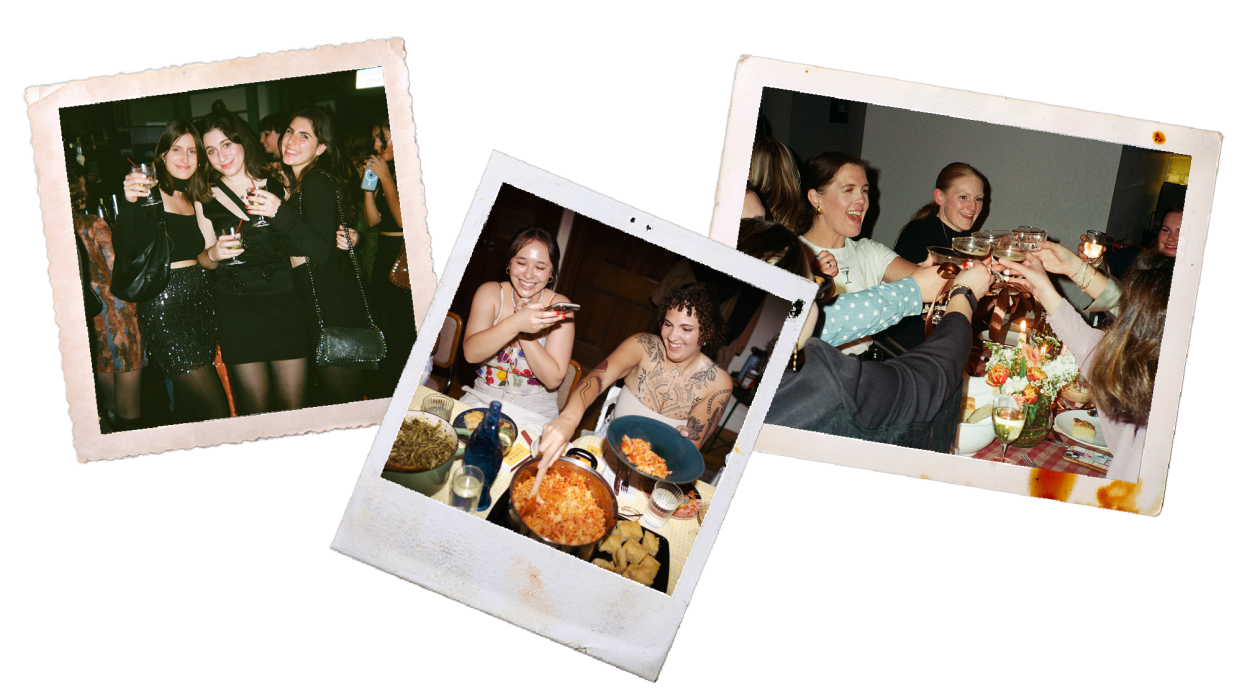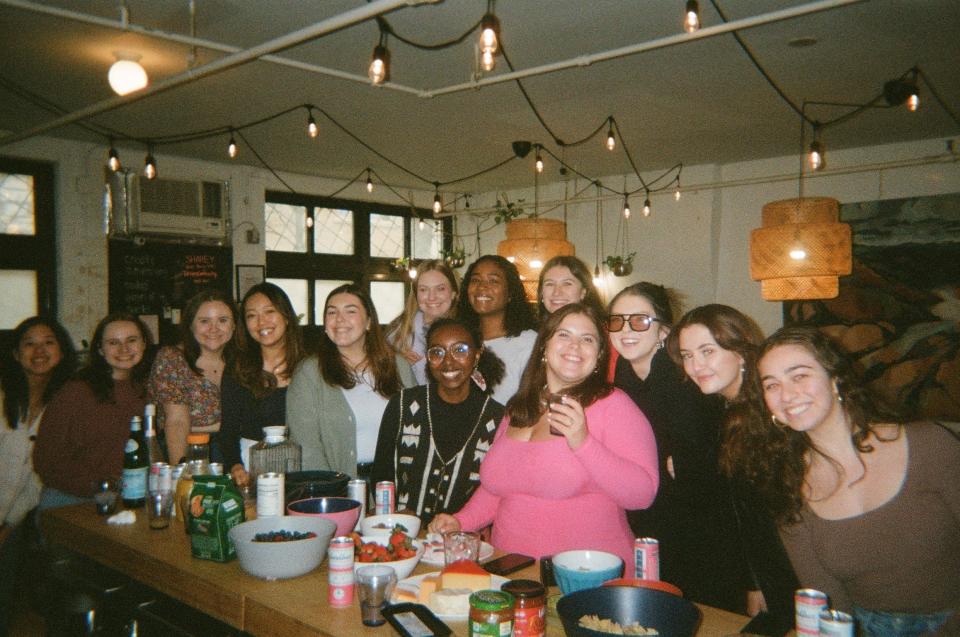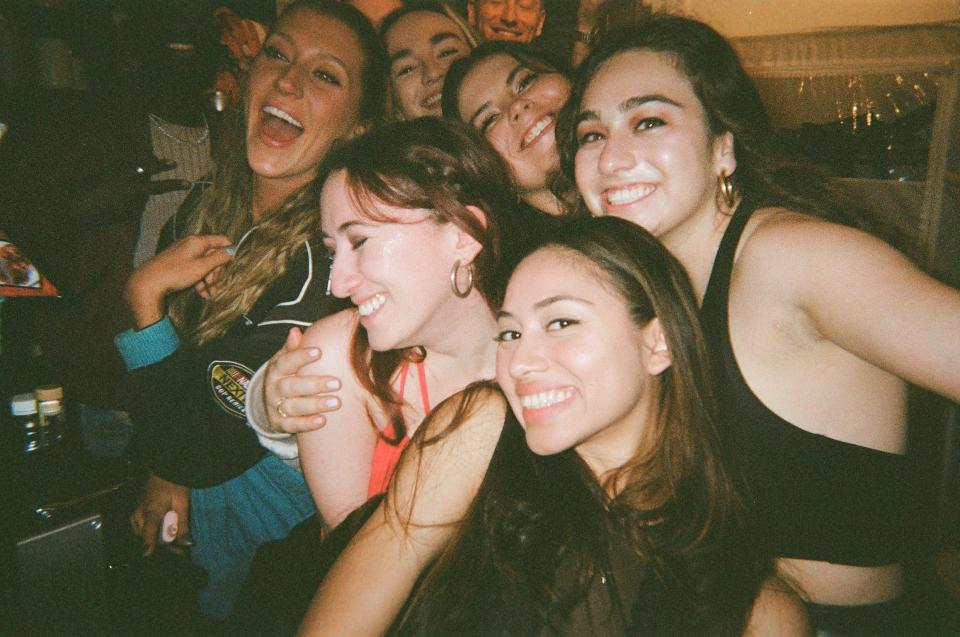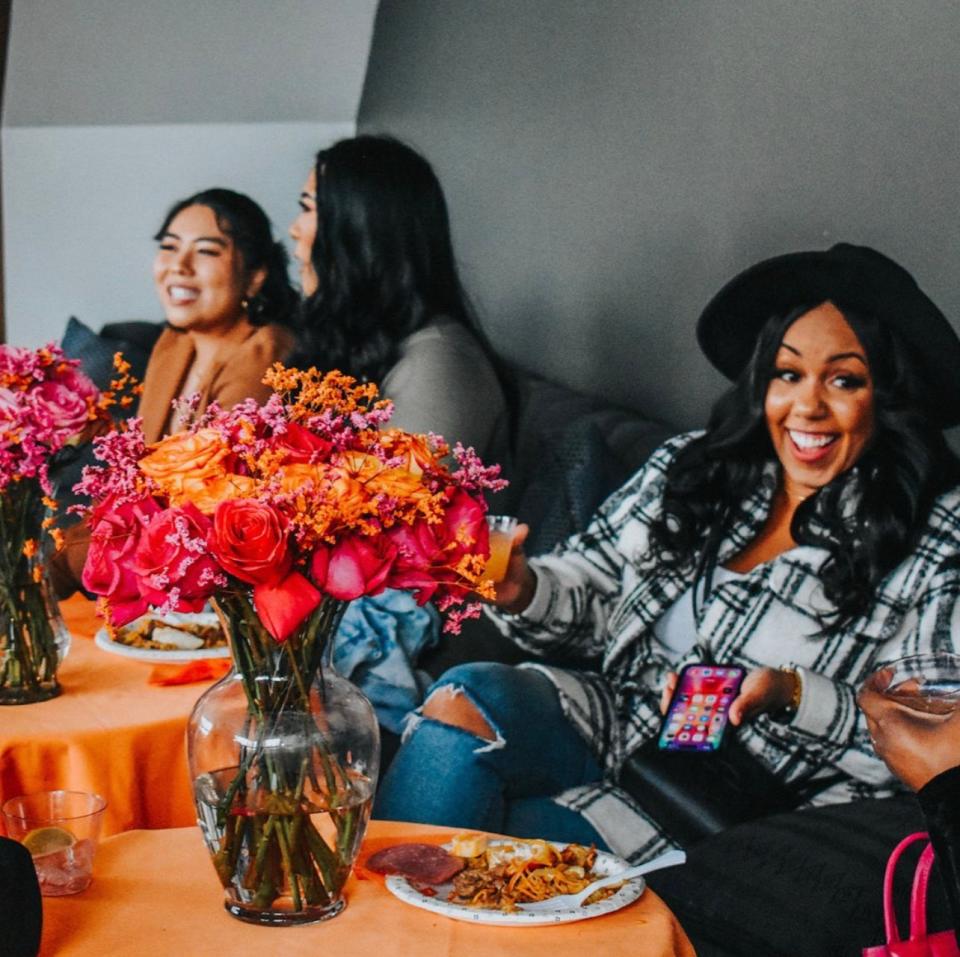The “Loneliest Generation” Is Transforming the Dinner Party

Courtesy of The Girls NYC; Courtesy of Dinner with Friends; Apertivo Society
Alessandra Abelli was quick to assure me that she did have friends. In fact, the chatty 24-year-old business analyst says she has always made friends easily. But after moving to New York post-college, she found them “scattered.” Many worked long hours in finance or consulting, others were busy working through graduate degrees. Abelli’s remote work setup meant no bonding at the office, and opportunities to meet new people in the wild felt few and far between. “Maybe this is a consequence of our generation and living digitally, but I feel like if I were to randomly go up to people and talk to them, they would probably be creeped out,” she says.
So Abelli started searching. After lots of googling and spending time on an app called Geneva, which aims to connect people based on similar interests, Abelli was here, at Fornino, a rooftop pizza restaurant, for a dinner with 20 strangers. She, like everyone else eating fig and prosciutto pizzas and sipping hibiscus margaritas, was there to make new friends.
Abelli’s dinner had been organized by a New York group called The Girls NYC, which describes itself as “an exclusive social group for NYC women in their early 20s looking to make meaningful friendships.” It’s one of many such collectives that have sprung up around the country dedicated to connecting people in real life over a meal in the hopes of making new friends.
Skip the Small Talk, with outposts from Providence to San Francisco, hosts regular mixers at local breweries and bars. Los Angeles’s Bestie Brunch gathers women for a Champagne and mimosa brunch to meet new friends. In Boston, the Aperitivo Society hosts themed multicourse dinners (oysters and wine! a Beantown bean bash!), often bringing in brand or chef collaborators, for a dozen people or less at a time, while the Dinner Party Project in Orlando brings eight strangers together over cocktails, an ornate tablescape, and a four-course meal prepared by a private chef.


Dinner parties are not exactly new, nor is the basic, human desire to connect with others. But these days, we’ve found ourselves lonelier than ever. According to a 2023 report from the Surgeon General, we’re in an “epidemic of loneliness and isolation.” People aged 15 to 24 are spending the least amount of time with each other, leading some to call Gen Z “the loneliest generation.” In a 2023 Pew Research Poll, less than a third of respondents under 30 said they had five or more close friends. Faced with isolation, young people across the country, particularly women, are using social media to organize dinners, brunches, and drinks meetups in hopes of making friends—or at the very least, feeling less alone.
One gathering called Dinner With Friends, a monthly dinner party featuring a themed three-course meal in founder Anita Michaud’s Brooklyn Heights apartment, is in its second year and has a waiting list hundreds of names long. Michaud, a 25-year-old who works in human resources, is a lot like Abelli: She moved to New York in 2021, and while working her corporate job, she quickly found herself incredulous that in a city of millions, she felt alone. Michaud went to college close to home, so moving to New York meant leaving family and friends for the first time. Between starting a new job and adjusting to this new phase of adult life in a new city, Michaud felt a loss of identity—adrift. “I think it's something that a lot of people encounter,” she says.
After a couple test dinners with friends of friends, Michaud turned to social media, posting to TikTok and Instagram to get the word out about Dinner With Friends. It’s a strategy many of the founders I interviewed used. Aryn Morris, a 29-year-old elementary school teacher who created Bestie Brunch in LA, says it all started when she began posting on TikTok after what she describes as a “friend breakup” that left her feeling completely alone. “I started posting about how I was going to start going out by myself in hopes of making friends,” Morris says. Comments started tumbling in from others in similar situations. “Everyone in the comments was like ‘you’re so brave. I don’t have friends.’”
For some, there aren’t clear ways to meet new friends. Erin Hunerberg, 29, who’s attended dinners with Boston’s Aperitivo Society, says she felt unsure of the best way to spontaneously strike up a conversation with a stranger. Her boyfriend advised her to try to find friends while pursuing her own hobbies—at a yoga class, for instance—but Hunerberg said she just didn’t know how to weave the conversational magic to make the jump from yoga classmate to friendly acquaintance. The vast internet isn’t immediately helpful either. “You google how to make new friends and it doesn’t give you a very clear-cut answer,” says Leah Seldin, a 25-year-old graduate student who founded The Girls NYC. “I think that people feel very stuck.” The problem, she says, is that a lot of friend groups are formed in high school or college, and forming a new social circle—or folding yourself into an existing one—isn’t easy. “It can feel very cliquey,” she says. “It feels like I’m banging at the door and nobody’s answering.”

genZdinnerpartiesinline1.JPG
Food and drink has become a commonality in these initiatives, the idea being that sitting down to a meal encourages conversation and, thus, connection and friendship. But these events all take different approaches. Some, like Dinner with Friends and the Aperitivo Society, stick to limited seats—only eight to 12 people per meal. Smaller groups, they say, are less intimidating for newcomers. Each dinner has a theme (March Mushroom Madness at one Dinner With Friends event, and Espresso Martini Club at a recent Aperitivo Society dinner), which is often accompanied by handwritten menus, floral laden tablescapes, and followed up with vibey, low-light photos posted to Instagram.
On the other end of the spectrum, Bestie Brunch takes place at a different Los Angeles restaurant each month, and often has more than 200 attendees, all of whom are encouraged to come alone so that they’ll be more likely to talk to a stranger. The Girls NYC straddles the line between the two, with 20 to 30 attendees per dinner or brunch event. One thing they all have in common: a robustly curated social media presence rife with photos of attendees, smiling and posing with their newfound pals. Social posts are important since, via the magic of social media algorithms, they’re the way many people first hear of these groups. Swiping through photos and videos of smiling strangers hoping to become friends over a healthy portion of tortellini makes a convincing argument for trying the whole thing out for yourself.
It’s a heartwarming concept, the idea that we can conquer our loneliness and isolation over the course of a single dinner party. But how realistic is it? In interviews with people who’d attended one or more of these dinner parties, results were mixed. Hunerberg says she’s met a casual acquaintance—someone who she might see every two months or so at the Aperitivo Society dinner. Abelli, the determined extrovert who attended a dinner with The Girls NYC, has had a bit more success. “I went to drinks with a girl who I met from the group,” she says, “and I was going to do a workout class with another girl.” But out of everyone I spoke to, only Indra Kanwal, a 26-year-old living in Boston who’s attended several dinners at the Aperitivo Society, has found the kind of close-knit best friendships that seem almost too perfect to be real. “We have a friend group now,” Kanwal says. “The three of us cook dinner together once a week and rewatch old Sex and the City episodes.”
Seats at Michaud’s dinners are consistently filled with well-intentioned friend makers earnestly hoping to create a connection, but it’s difficult, she says, to pinpoint exactly how many last friendships are created from her dinners. They may not materialize in a single night; it’s about consistency and follow-through, she argues.
“I try to get folks to make plans before they eat because it’s so easy, once you leave, for the outside world to kind of creep in,” Michaud says. When you step back into your life, work and errands begin to feel more important than setting up a coffee date with a new friend. Outside of these dinners, where making friends is explicitly encouraged and expected, the same familiar obstacles are still present. How do you approach a stranger without feeling like a creep? How do you casually invite your yoga acquaintance to coffee without the crushing fear of rejection? In the end, though, there’s only so much a host can do to facilitate new friendships. “What I try to do is give people the tools to go as fast and as far as they want to go with their friendships that are being formed at the dinner,” Michaud says.
For Eliza Fitch, a 24-year-old actor who has now attended two Dinner With Friends events, deep, meaningful friendships haven’t happened yet. Instead, she says, she made sort-of friends that she sees mostly on Instagram. Every so often, they’ll react to one another’s Instagram stories, but none of the handful of women she’s met have reached out to set up a hangout in real life—and she hasn’t either. But Fitch struck me as a resolute optimist. One event was a bust? Why not try another, just in case? She doesn’t count her peripheral Instagram friends as a loss—they’re simply untapped potential friends, should the desire to reach out ever crystallize for her. “I feel like I wouldn’t call them a friend,” she says. “Yet.”
Originally Appeared on Bon Appétit
More Culture Stories From Bon Appétit
Get Bon Appétit in your inbox with our daily newsletter.
Nonalcoholic beverages are everywhere. This is how to choose the right one for any occasion.
What a 22-year-old server at a Michelin-Starred restaurant eats on $18/hour in New York.
A new season of ‘The Bear’ is on the way. Here's why we're excited.
Season 2 of ‘High on the Hog’ on Netflix shows how food powered the civil rights movement.
Chris Morocco solves your kitchen emergencies on our podcast Dinner SOS.
The Epicurious App is here with over 50,000 recipes.


